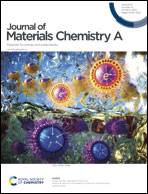Thermoelectric property enhancement by merging bands in NbFeSb-based half-Heusler mixtures†
Abstract
Half-Heusler (HH) materials with 18 electrons exhibit semiconducting behavior and are potential candidates for thermoelectric materials. Based on the well-studied 18-e NbFeSb compound, we mix the corresponding 17-e and 19-e systems to construct the novel 18-e HH compounds: replacing the Fe or Nb elements with their corresponding left and right elements in the periodic table (Mn and Co for Fe; Zr and Mo for Nb). Two new thermodynamically stable 18-e HH compounds (Nb4Mn2Co2Sb4 and Zr2Mo2Fe4Sb4) are predicted using the cluster expansion methodology. Owing to the merging valence band maximum in 17-e NbMnSb and 19-e NbCoSb, the Nb4Mn2Co2Sb4 mixture possesses high band degeneracy (NLv = 16) and significantly boosts the Seebeck coefficient and the power factor, much higher than those of NbFeSb. Additionally, the complex geometries and soft acoustic branches in Nb4Mn2Co2Sb4 and Zr2Mo2Fe4Sb4 induce lower thermal conductivities than NbFeSb. Finally, the calculated p-type (n-type) zT value of Nb4Mn2Co2Sb4 can reach 0.72 (0.62) at 1000 K, higher than that of pristine NbFeSb. Our results not only provide a new HH research system for experiments, but also provide a band engineering methodology for the preparation of HH thermoelectric materials with excellent performance.



 Please wait while we load your content...
Please wait while we load your content...